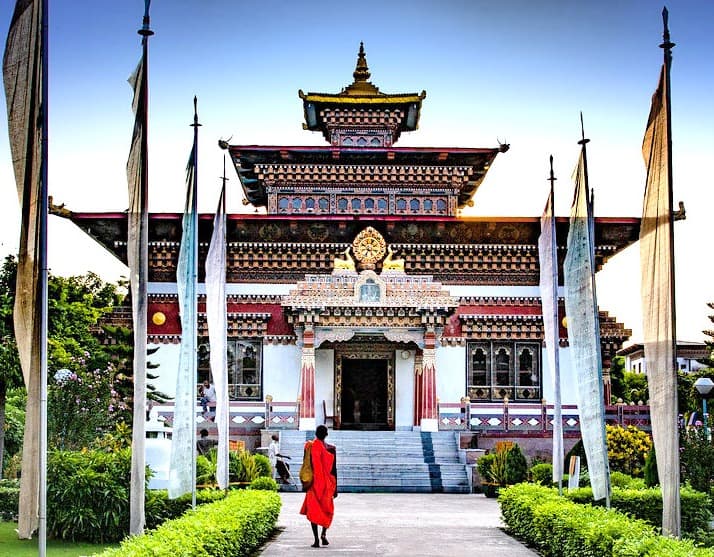- Discovering Bhutan: The Land of Happiness
- Essential Travel Information for Visiting Bhutan
- Navigating Bhutan's Distinctive Tourism Policy
- Cultural Etiquette and Respectful Travel
- Unforgettable Destinations in Bhutan
- Extraordinary Experiences with Druk Holidays
- Practical Travel Tips for a Smooth Bhutan Experience
Ever wondered why Bhutan is called the "Last Shangri-La"? It's not just a catchy nickname – it's because this tiny Himalayan kingdom feels like the last untouched paradise on Earth.
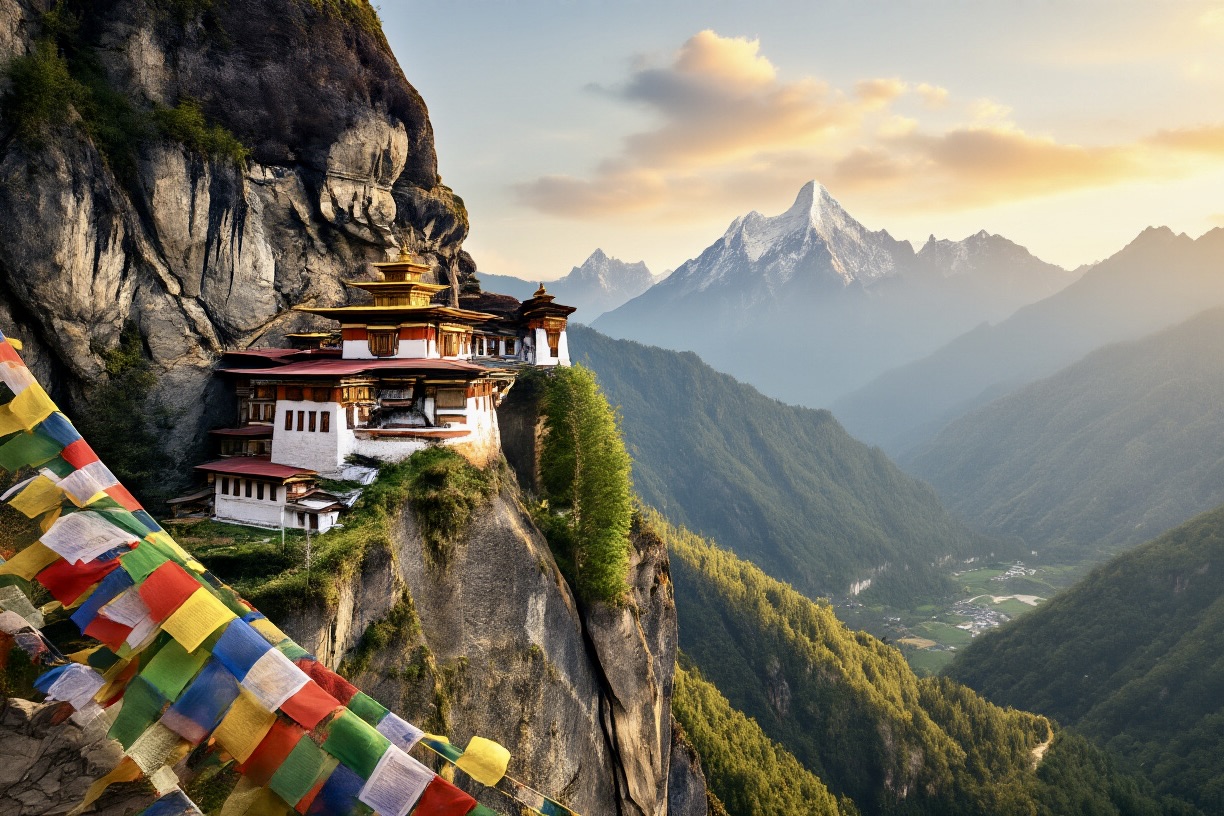
Planning a Bhutan tour feels overwhelming at first. So much to see, so many cultural nuances to understand, and honestly, not enough practical information in one place.
I've spent years guiding travelers through Bhutan's dzongs, high mountain passes, and hidden valleys. What I've learned is that the right preparation transforms your journey from a standard vacation into something profoundly life-changing.
This comprehensive Bhutan tour guide covers everything from visa requirements to cultural etiquette – the exact blueprint I wish I'd had before my first visit. But what really separates memorable Bhutan experiences from disappointing ones? The answer might surprise you.
Discovering Bhutan: The Land of Happiness
Bhutan's Unique Cultural Identity
Ever seen a country where ancient traditions aren't just preserved but actually lived every day? That's Bhutan for you.
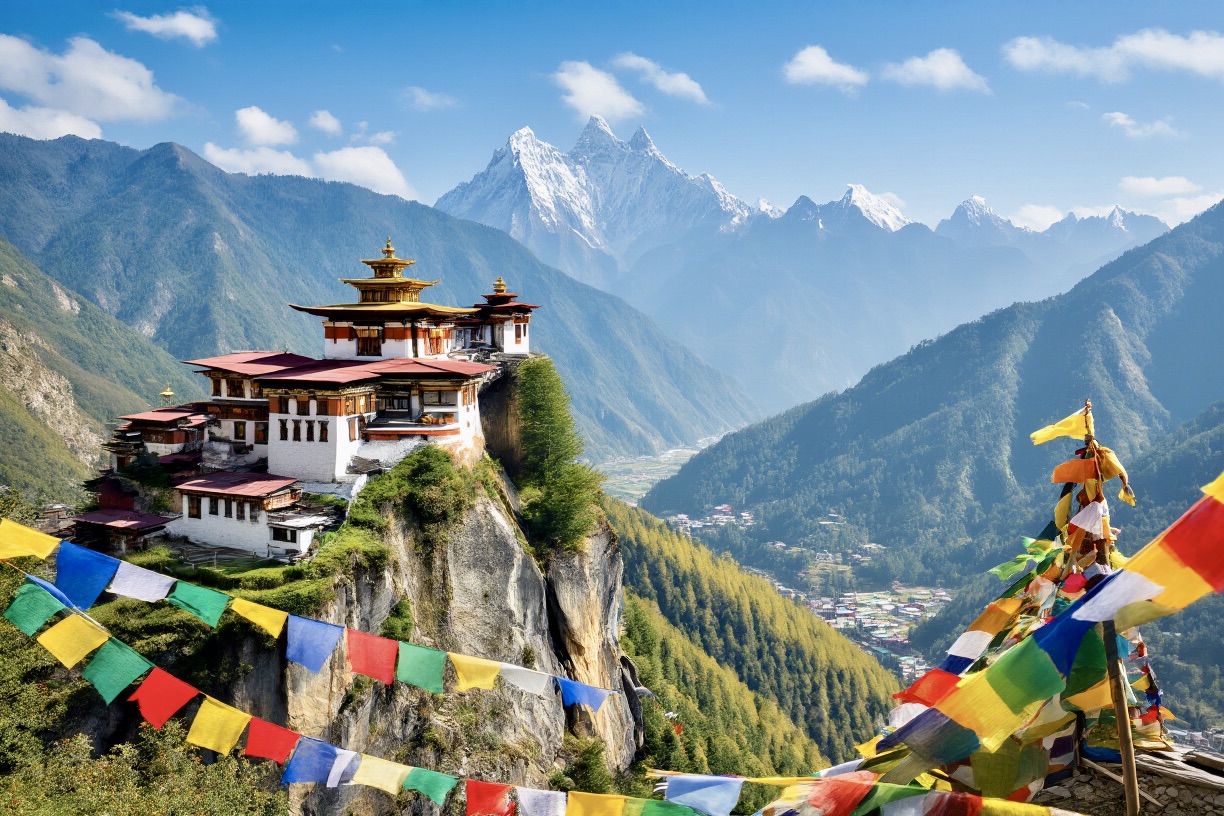
Bhutanese culture stands out like nothing else on earth. The national dress—ghos for men and kiras for women—isn't just for special occasions. People wear these colorful garments daily, keeping centuries-old traditions alive in the most natural way.
Buddhism isn't just a religion here—it's woven into every aspect of life. Colorful prayer flags flutter across mountain passes, massive dzongs (fortress-monasteries) dominate valley landscapes, and monks in crimson robes are as common a sight as business people in cities elsewhere.
The architecture? Absolutely stunning. No boring concrete boxes here. Every building follows traditional designs with intricate woodwork, sloped roofs, and colorful paintings of dragons, tigers, and religious symbols.
Geographical Wonders of the Dragon Kingdom
Bhutan packs an almost ridiculous amount of natural beauty into a country smaller than Switzerland.
The southern foothills rise dramatically from the Indian plains into dense subtropical forests. Move north and you'll find yourself in temperate valleys where most Bhutanese live and farm. Keep going and the terrain transforms into alpine meadows before hitting the snow-capped Himalayan peaks that form a natural barrier with Tibet.
Some valleys remain so isolated that each has developed its own dialect and customs. The famous Paro Valley houses the iconic Tiger's Nest Monastery, while Bumthang is considered Bhutan's spiritual heartland.
Rivers carve deep gorges through the landscape, creating natural highways that have shaped settlement patterns for centuries.
Gross National Happiness: Bhutan's Guiding Philosophy
Most countries obsess over GDP. Bhutan? They measure GNH—Gross National Happiness.
This isn't some cute marketing slogan. It's a serious governing philosophy introduced by the Fourth King in the 1970s that shapes every policy decision.
The GNH approach balances material progress with spiritual, cultural, and environmental well-being. When considering development projects, Bhutanese officials don't just ask "Will this make money?" but "Will this make people happier?"
This philosophy explains many of Bhutan's distinctive policies:
- Mandatory traditional architecture
- Free healthcare and education
- Constitutional requirement to maintain 60% forest cover
- Controlled tourism to prevent cultural dilution
Tourism itself operates under the "high value, low impact" model. Yes, you'll pay more to visit than neighboring countries, but you'll experience a culture and landscape that hasn't been compromised by mass tourism.
Essential Travel Information for Visiting Bhutan
Visa Requirements and Entry Procedures

Getting into Bhutan isn't like popping over to your neighbor's house. Every tourist (except Indian, Bangladeshi, and Maldivian nationals) needs a visa. But here's the good part – you don't have to deal with embassy paperwork. Your Bhutanese tour operator handles everything.
You'll need:
- A valid passport with at least 6 months' validity
- Completed visa application form
- The visa fee (usually included in your tour package)
Once approved, you'll receive a visa clearance letter that you'll present upon arrival. The actual visa gets stamped in your passport at the port of entry. Simple as that!
Best Times to Visit for Optimal Experiences
Bhutan's a year-round destination, but timing matters depending on what you're after.
Spring (March-May): Rhododendrons explode across hillsides with color. Perfect for photography and moderate hiking.
Fall (September-November): The absolute sweet spot. Clear mountain views, comfortable temperatures, and major festivals.
Summer (June-August): Lush and green, but expect afternoon showers. Great hotel deals though!
Winter (December-February): Crisp blue skies in valleys, snowcapped peaks, and fewer tourists. Just pack those layers – higher elevations get seriously cold.
Currency and Payment Options
The Bhutanese Ngultrum (BTN) is pegged to the Indian Rupee. Both currencies work throughout Bhutan, except for 500 and 2000 Indian Rupee notes, which aren't accepted.
Cash is king here. Credit cards work in higher-end hotels and some souvenir shops in Thimphu and Paro, but don't count on them elsewhere. ATMs exist in major towns, but they're not always reliable.
Smart move? Bring US dollars or Euros to exchange. You'll find currency exchange at the airport, banks, and larger hotels.
Language and Communication Tips
Dzongkha is the official language, but don't panic! English is widely spoken, especially in tourism areas. It's taught in schools and used for government business.
Some handy Dzongkha phrases to break the ice:
"Kuzu zangpo" = Hello
"Kadrinche" = Thank you
"La" = Yes (add it to sentences to show respect)
Bhutanese appreciate foreigners making even small attempts at their language. They'll smile, you'll smile – communication magic.
Connectivity and Internet Access
Gone are the days when visiting Bhutan meant going completely off-grid. Most hotels, restaurants, and cafés in towns offer Wi-Fi, though speeds might test your patience.
Mobile coverage is surprisingly good in populated areas. You can purchase a local SIM card at the airport or in Thimphu with your passport. B-Mobile and TashiCell are your main options.
Just remember – the internet might vanish completely when you're exploring remote valleys or high mountain passes. Consider it a feature, not a bug. Sometimes, disconnecting is the whole point of visiting Bhutan.
Navigating Bhutan's Distinctive Tourism Policy
Understanding the Daily Tourism Tariff
Bhutan's not your typical vacation spot – and that's by design. The country charges a daily fee for tourists, the Sustainable Development Fee (SDF) sits at $100 per person per day.
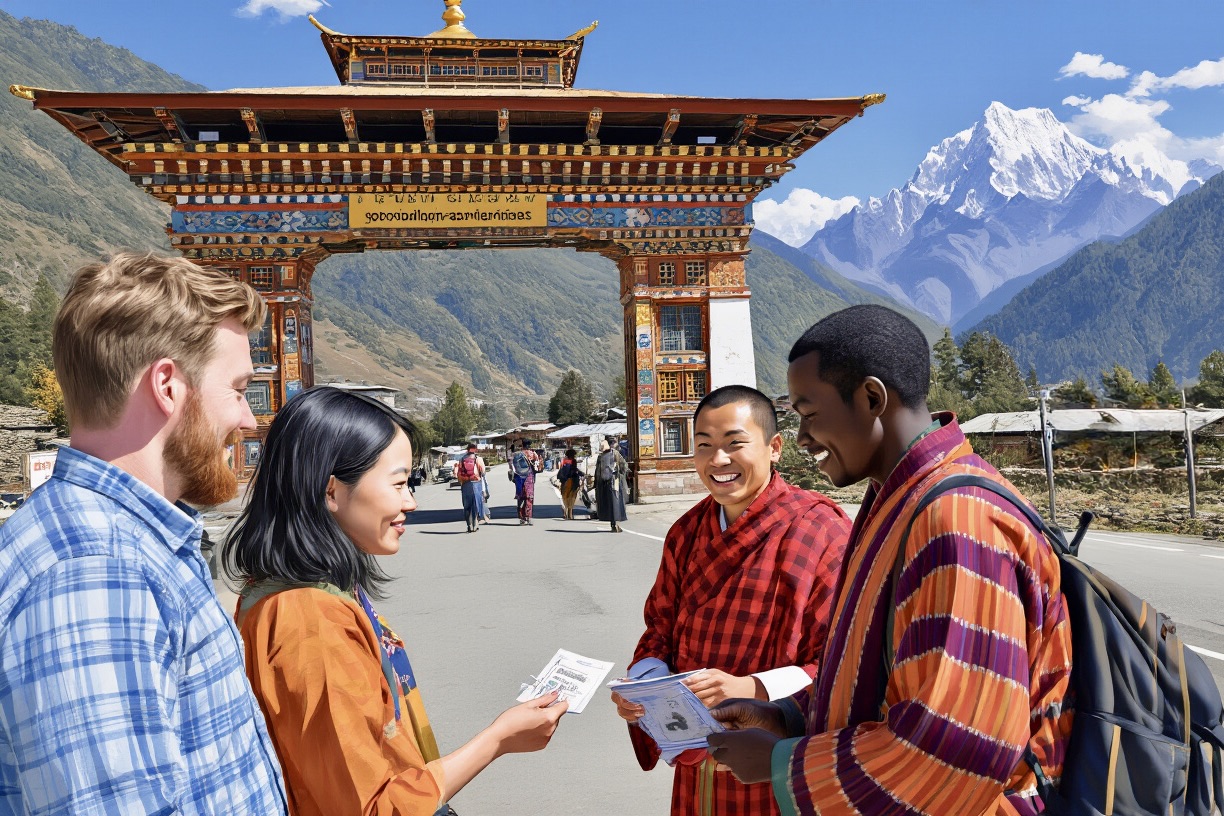
But here's the thing – this isn't just another tourist tax. This money directly funds free healthcare, education, and infrastructure for Bhutanese citizens. About 30% goes straight to social services. When you pay this fee, you're literally helping send kids to school.
Licensed Tour Operator Requirement
Thinking of going solo in Bhutan? Think again. The kingdom requires all international visitors (except those from India, Bangladesh, and the Maldives) to book through licensed Bhutanese tour operators.
This isn't just bureaucratic red tape. Local operators understand the terrain, culture, and regulations that might leave you scratching your head. They'll handle your visa processing, itinerary planning, and can access places that would otherwise be off-limits.
Benefits of Bhutan's High-Value, Low-Impact Tourism Model
Bhutan's approach to tourism isn't accidental – it's their secret sauce for preserving what makes the country special.
By limiting tourist numbers through pricing, Bhutan avoids the overtourism nightmare plaguing places like Venice or Bali. Their forests still cover over 70% of the country, and their cultural sites aren't overrun with selfie sticks.
This model also ensures tourism benefits actually reach Bhutanese communities. The money flows directly into local businesses, not international hotel chains. Visitors who come tend to stay longer and engage more deeply with the culture.
And you know what? The experience is better for it. When you're hiking to Tiger's Nest Monastery, you'll encounter contemplative silence, not crowds jostling for the perfect Instagram shot.
Services Included in Your Package
Your Bhutanese adventure comes with some serious perks built into your tour package:
- Licensed guides who speak your language and know their stuff
- Comfortable transportation throughout your journey
- Accommodation in government-approved hotels (typically 3-star, with upgrades available)
- Three meals daily featuring authentic Bhutanese cuisine
- All internal taxes and charges
- Entrance fees to museums and cultural sites
What's not covered? Your international flights, travel insurance, and personal expenses like souvenirs or alcoholic drinks. Those are on you.
Cultural Etiquette and Respectful Travel
Dress Code Guidelines for Temples and Dzongs
Bhutanese take their sacred spaces seriously, and your outfit matters. When visiting temples and dzongs, cover those shoulders and knees - this isn't optional. Women should wear long skirts or pants with tops that cover their arms. Men need long pants and shirts with sleeves.
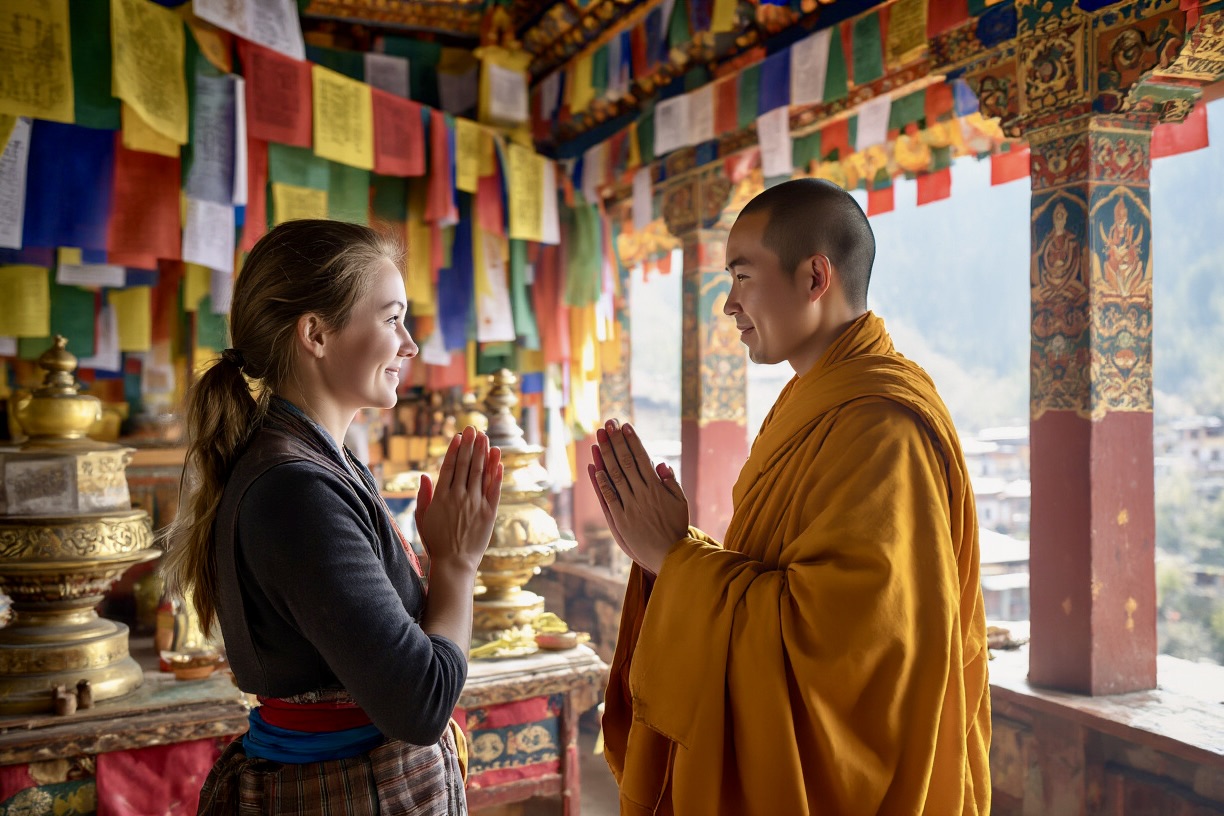
Got a scarf? Bring it. You might need to cover your head in certain areas. And those flip-flops? Leave them at the hotel. Proper shoes that you can easily remove are perfect since you'll be taking them off before entering the temple interiors.
Remember - these aren't just tourist attractions. They're active religious sites where locals worship daily. Dressing respectfully isn't about rules; it's about showing you understand what these places mean to Bhutanese people.
Photography Rules at Sacred Sites
That amazing Buddha statue you want to photograph? Ask first. Many sacred sites in Bhutan prohibit photography inside temple buildings, especially of religious artifacts and ceremonies.
Always look for signs or ask your guide before clicking. When photography is allowed, never use flash as it can damage centuries-old paintings and disturb worshippers.
Want to photograph monks or people praying? Get permission first. A smile and a respectful gesture go a long way.
Appropriate Behavior in Religious Settings
Bhutanese temples are peaceful havens, not tourist playgrounds. Keep your voice down and move clockwise around religious objects - always in a clockwise direction.
Never touch religious artifacts, paintings, or statues unless invited to do so. If you see people praying, give them space.
Monks deserve special respect. Don't interrupt their ceremonies or meditation. If you want to give offerings, your guide can advise on appropriate items and methods.
Tipping Practices
Tipping isn't traditionally Bhutanese, but it's becoming more common in tourist areas. Your guides and drivers will appreciate a gesture of gratitude - typically $8-10 per day for guides and $5-7 for drivers.
At hotels, $1-2 per bag for porters works well. Restaurant tipping isn't expected but rounding up the bill is appreciated for good service.
The key is discretion. Hand tips directly to the recipient in an envelope if possible. Don't make a show of it - Bhutanese culture values humility and understatement.
Unforgettable Destinations in Bhutan
Thimphu: The Modern Capital with Traditional Charm
Ever been to a capital city that feels like stepping into a living museum? That's Thimphu for you. The only capital without traffic lights – they tried one, but locals thought it was too impersonal!
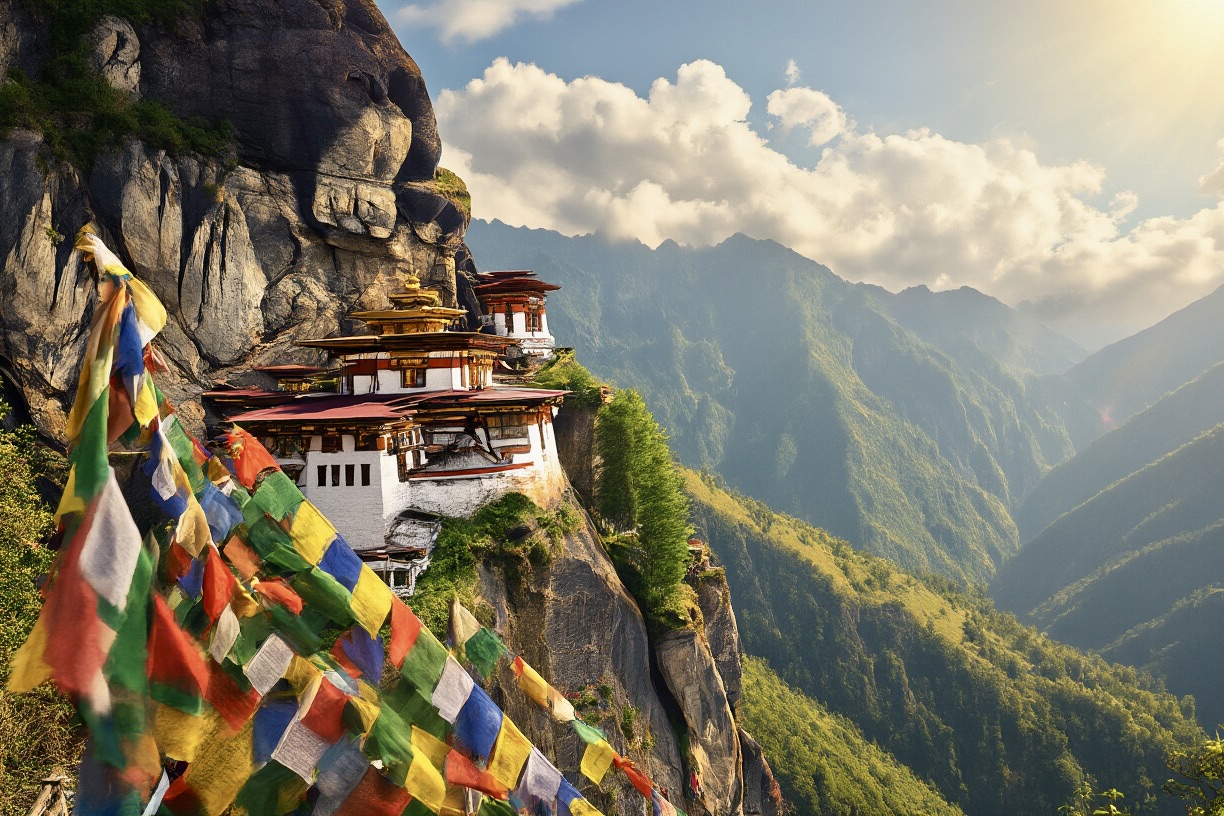
Instead, you'll find white-gloved police officers directing traffic with graceful movements that look straight out of a dance performance. It's oddly mesmerizing to watch.
The massive Buddha Dordenma statue sits on a hilltop, keeping watch over the valley. At 169 feet tall and filled with 125,000 smaller Buddha statues, it's not just impressive – it's jaw-dropping when you stand beneath it.
Don't skip the weekend market where locals haggle over dried chilis, cheese, and handcrafts. The scent of incense mixes with mountain air as monks wander past government officials dressed in traditional ghos and kiras.
Paro and the Iconic Tiger's Nest Monastery
Paro Valley hits you with that picture-perfect Bhutan you've seen on travel sites. But nothing prepares you for Tiger's Nest Monastery (Taktsang) in real life.
Clinging to a cliff 3,000 feet above the valley floor, getting there is half the adventure. The 2-3 hour hike up might leave you breathless, both from the thin air and the views. Seriously, pack good shoes and take it slow.
There's something magical about reaching the monastery after that climb. Prayer flags flutter in the wind, and the silence is broken only by the occasional chanting. Legend says Guru Rinpoche flew here on a tigress to meditate. After that hike, you'll wish you had a flying tiger, too!
Paro town itself is charming with traditional Bhutanese architecture and the impressive Paro Dzong (Rinpung Dzong) that's featured in Little Buddha.
Punakha's Historic Dzong and River Valleys
Punakha feels like Bhutan's sweet spot. The climate's milder, the valleys lusher, and the rice fields create patterns that look like they've been painted on the landscape.
The star attraction? Punakha Dzong. Built where two rivers meet (the male Pho Chu and female Mo Chu), it's considered Bhutan's most beautiful fortress. In spring, the jacaranda trees explode with purple blooms against the white walls.
The dzong has survived earthquakes, fires, and floods over its 400-year history. Walking across the wooden cantilever bridge to reach it feels like crossing into another time.
For a bit of fun local history, ask about the Divine Madman and visit Chimi Lhakhang (the fertility temple). The phallus symbols painted on houses around here aren't what you think – well, they are, but there's a fascinating story behind them!
Bumthang: Bhutan's Spiritual Heartland
Bumthang isn't one place but four valleys that form Bhutan's spiritual center. This is where Buddhism first took root in Bhutan, and you can feel it.
The air seems different here – thinner, clearer, charged with something you can't quite name. Ancient temples like Jambay Lhakhang (dating to the 7th century) host festivals where fire dances drive away evil spirits.
Wander through buckwheat fields to reach monasteries where legends are as plentiful as prayer wheels. The Swiss cheese and honey produced here are surprisingly delicious side notes to your spiritual journey.
Off-the-beaten-path Destinations
Beyond the tourist circuit lies the real Bhutan that few visitors experience.
Haa Valley remains gloriously untouched, with pine forests and traditional farmhouses dotting the landscape. Being one of the least visited areas, you'll often find yourself alone on hiking trails with just prayer flags and mountain views for company.
Gangtey Valley (Phobjikha) transforms each winter when black-necked cranes migrate from Tibet. Locals celebrate their arrival with festivals, believing these birds bring good fortune.
Eastern Bhutan – particularly Trashigang and Mongar – offers glimpses into rural Bhutanese life largely unchanged by tourism. The weaving traditions here produce some of the most intricate textiles in the country.
The remote Merak and Sakteng regions let you encounter the semi-nomadic Brokpa people with their unique yak-hair hats and distinct cultural practices that feel like stepping into National Geographic.
Extraordinary Experiences with Druk Holidays
Cultural Festival Immersions
Ever watched people dance in traditional costumes that tell stories centuries old? In Bhutan, you don't just watch – you become part of it. Our cultural festival tours drop you right into Bhutan's most vibrant celebrations, where masked dancers twirl and locals gather in their finest traditional garb.
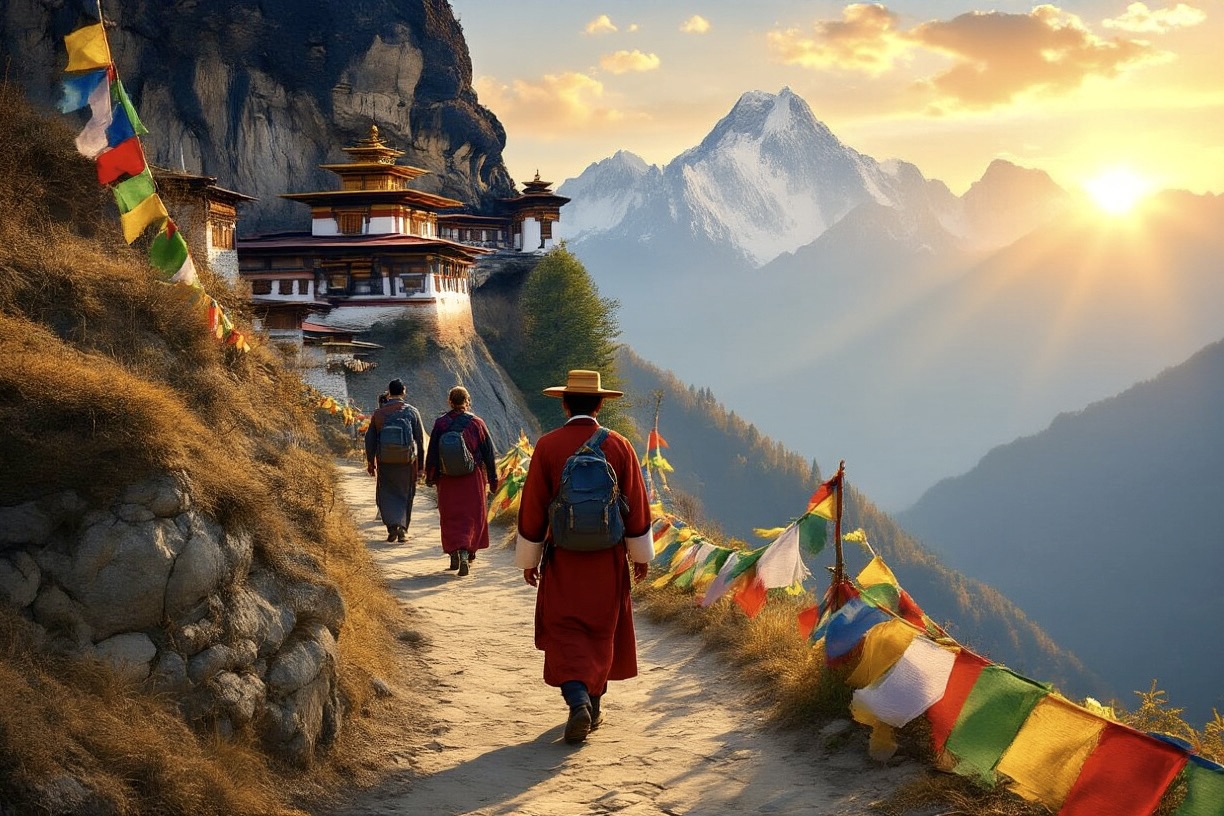
These aren't tourist traps. These are the real deal – festivals that Bhutanese people have celebrated for generations. You'll stand shoulder-to-shoulder with monks and farmers alike, all celebrating centuries-old Buddhist traditions.
The Paro Tshechu? It's mind-blowing. Imagine hundreds of people gathered in a fortress courtyard at dawn, waiting for the unfurling of a massive tapestry depicting Buddhist deities. The collective gasp when it appears is something you'll never forget.
Hiking and Trekking Adventures
Bhutan's trails aren't like anywhere else on earth. One minute you're walking through pine forests so quiet you can hear your heartbeat, the next you're staring at Himalayan peaks that make you feel tiny in the best possible way.
Our guides know these mountains like the backs of their hands. They'll take you to hidden monasteries perched on cliffs where monks meditate in complete isolation. They'll point out rare blue poppies that only bloom in these remote valleys.
The Tiger's Nest trek? Yeah, it's challenging. But when you round that final corner and see the monastery clinging to the cliff face – trust me, every drop of sweat becomes worth it.
Traditional Homestay Experiences
Forget hotels. The real magic happens when you're sitting cross-legged on cushions in a farmhouse kitchen, watching your host family prepare butter tea over an open fire.
Our homestay experiences connect you with families who open their doors and their lives. You'll help grandma pick chilis from the garden. You'll learn to make ema datshi (that spicy cheese dish Bhutanese people are crazy about). You'll sleep under handwoven blankets in rooms warmed by traditional bukhari stoves.
These aren't staged experiences. These are real homes where you become temporary family members. When the kids teach you traditional games by candlelight, that's the Bhutan tourists rarely see.
Authentic Culinary Journeys
Bhutanese food isn't just food – it's a fiery, complex journey through a culture that values heat, flavor and simplicity. Our culinary tours take you beyond restaurants into kitchen gardens, village markets and cooking hearths.
You'll forage for wild ferns alongside local guides who know exactly which ones make the best dishes. You'll learn why red rice is sacred in Bhutan, and why no meal feels complete without some eye-watering chili.
In one mountain village, we visit a family who makes ara (traditional rice wine) using techniques passed down through generations. They'll show you how to distill it using bamboo pipes and clay pots, then invite you to sample the results under peach trees in full bloom.
Practical Travel Tips for a Smooth Bhutan Experience
Packing Essentials for Bhutan's Varied Climates
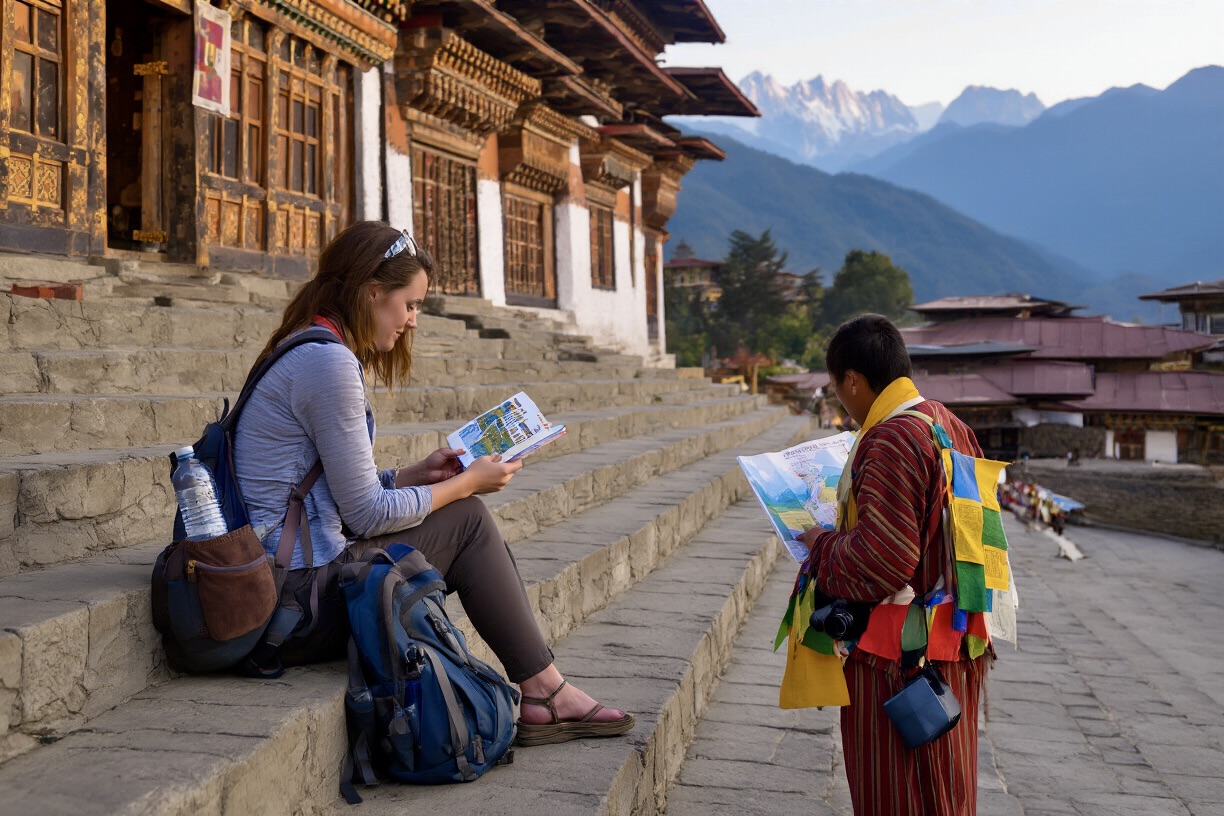
You'll thank yourself later for packing layers in Bhutan. The weather here plays tricks - warm sunshine one minute, chilly mountain air the next.
Pack these non-negotiables:
- Lightweight, moisture-wicking base layers
- A good mid-layer fleece or wool sweater
- Waterproof jacket (rain is unpredictable)
- Sturdy walking shoes broken in before your trip
- Sun protection (hat, sunglasses, high SPF sunscreen)
- Modest clothing for temple visits (shoulders and knees covered)
Summer travelers (June-August): Bring a quality raincoat and quick-dry clothes. Those afternoon showers come out of nowhere.
Winter visitors (December-February): Don't skimp on warm gear. Temperatures drop below freezing at night.
Health and Altitude Considerations
Altitude sickness isn't just hiker talk in Bhutan. Many places sit above 7,000 feet, and your body will notice.
Smart moves to avoid the headache (literally):
- Drink water like it's your job (3-4 liters daily)
- Skip alcohol for the first few days
- Take it slow, your first 48 hours
Pack basic meds: ibuprofen, digestive aids, and altitude medication if prescribed
Bring any prescription medications in their original packaging with a doctor's note. Medical facilities outside Thimphu are basic, so a small first aid kit is smart.
Transportation Within Bhutan
Getting around Bhutan isn't complicated, but it does require planning.
Your main options:
- Private car with driver (most common and convenient)
- Domestic flights between major destinations
- Local buses (adventurous but time-consuming)
The roads are winding mountain passes with jaw-dropping views, but can test your motion sickness tolerance. Bring medication if you're prone to queasiness.
Most tour packages include transportation, and this is one place where having arrangements made in advance pays off.
Recommended Accommodations Across Budget Ranges
Bhutan's accommodation scene has evolved dramatically. You'll find options from basic guesthouses to luxury retreats.
Budget-friendly ($50-100): Clean, comfortable guesthouses or 2-star hotels. Basic amenities but authentic experiences. Try family-run places in Paro and Punakha.
Mid-range ($100-250): 3-star hotels with reliable hot water, decent WiFi, and restaurant options. Dewachen Hotel in Phobjikha Valley offers spectacular views.
Luxury ($250+): 5-star experiences like Zhiwa Ling in Paro or COMO Uma properties combine traditional architecture with modern comforts. Worth the splurge for at least a night or two.
The best accommodations book up months in advance during peak seasons (March-May and September-November). Don't wait to reserve.
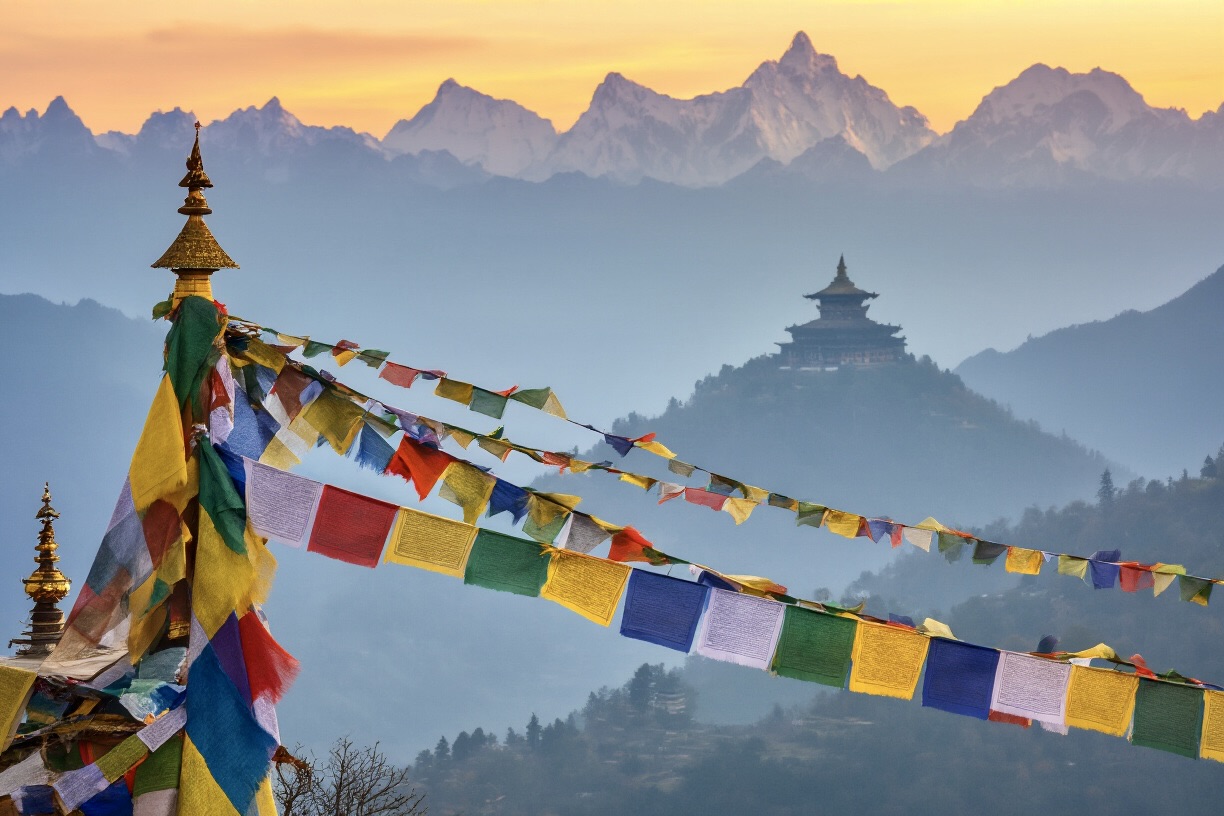
Bhutan, known as the Land of Happiness, offers travelers a truly unique experience with its pristine landscapes, vibrant cultural heritage, and commitment to Gross National Happiness. From understanding the country's distinctive tourism policy to exploring unforgettable destinations like Tiger's Nest Monastery and Punakha Dzong, a journey through this Himalayan kingdom promises authentic encounters with both tradition and natural beauty. Respecting local customs and etiquette enhances your connection with the Bhutanese people and their way of life.
Planning your Bhutan adventure with Druk Holidays ensures you'll receive expert guidance through every aspect of your journey. Whether you're seeking spiritual enrichment, cultural immersion, or breathtaking hiking trails, the right preparation will transform your visit into a life-changing experience. Embrace the opportunity to disconnect from the modern world and discover the profound wisdom in Bhutan's thoughtful approach to life and happiness.


